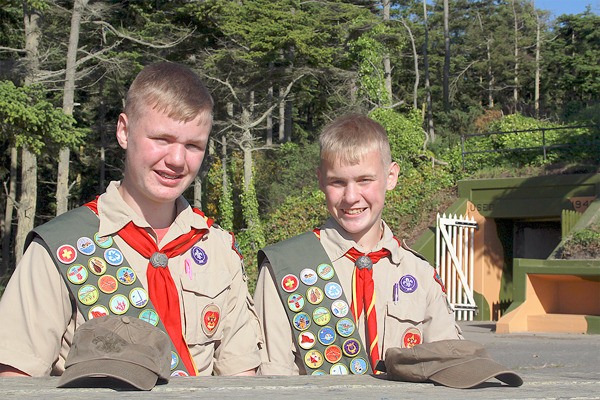The idea of placing detailed restoration work of an old Army fortification into the hands of a couple of teenagers didn’t come without careful thought and a certain level of risk by Steve Kobylk.
Kobylk, a stickler to detail and Whidbey Island’s resident expert of former military forts in Coupeville, had been talking about getting to a project at Fort Ebey State Park since before the turn of the century but other volunteer work kept rising higher on the priority list.
So when a pair of 14-year-old twins from Oak Harbor announced earlier this year they wanted to tackle some restoration work at one of the old forts on Central Whidbey for two different Eagle Scout projects, Kobylk sized up the candidates and decided to place the responsibility into their young hands.
And he’s glad he did.
The twins, Ryan and Christian Vasileff, spent 20 hours at Fort Ebey last weekend, overseeing two simultaneous projects that have given the entrances to the battery emplacement a fresh yet more authentic look.
Once dull and gray, the three entrances are now painted in similar camouflage colors and patterns that were represented when the coastal defense fort was used by the Army during World War II.
That project was led by Christian.
Also new are the wooden gates in each of the entrances and two steel screens installed to protect park visitors from entry ways that posed a safety hazard.
Ryan was in charge of that project.
The results exceeded the expectations of Kobylk, who’s led several restoration projects at both Fort Casey and Fort Ebey.
“I think they did an outstanding job,” said Kobylk, who lives in Coupeville. “They did actually more than was expected of them.
“I’ve done a lot of Eagle Scout projects. It’s the only one I’ve seen where there were two Eagle Scout projects at the same place and at the same time.
“They had to work together in order to work around each other in the same spaces. For kids that age, that takes a lot of patience and skill.”
Among the requirements to be awarded Eagle Scout, the highest rank in Boy Scouts, the Vasileffs needed to lead a service project to benefit a religious organization, school or community.

When it came time to think of the idea, their minds returned to a place where they’ve spent so much time having fun while growing up.
“We always wanted to do something at one of the forts,” Christian said.
To comply with Eagle Scout protocol, the twins could only lead their projects and weren’t allowed to do much of the heavy lifting themselves.
That meant that the teenagers were in charge of about two dozen helpers, which included adults such as Kobylk and their parents Jim and Jennifer Vasileff. The work party also included members from their Sedro-Woolley-based Boy Scout Troop 4067, Skagit Crew 1022 from Burlington and Oak Harbor High School’s NJROTC.
Even their little brother, Justin, 12, also a Boy Scout, helped.
The work crew camped over the weekend at the park and put 20 hours into the project, finishing late Sunday.
“It was just amazing,” said Jim Vasileff. “Coordinating 25 people at their age, it is hard. I watched how hard it was for them over two days.
“We’re very proud of them. Their brother’s right behind them, too.”
The twins said they relied heavily on the expertise and historic knowledge of Kobylk, the island’s field representative of the national Coast Defense Study Group and Fort Casey State Park volunteer.
Kobylk provided the last original remaining gate so Ryan could draw up plans to build replicas to connect to steel hinges fabricated by state parks workers.
But there was a snag.
“They made all six gates. They assembled them onsite,” Kobylk said. “When we went to fit the gates on the hinges, they didn’t fit right.
“Some of the concrete had shifted over the last several years.”
Modifications to the wooden boards were made onsite, which impressed Kobylk.
“They took the initiative to see what the issues were, corrected the issues and fixed them that weekend on the spot and installed them,” he said.
“I am amazed we got it all done,” Ryan said.
Kobylk couldn’t have been happier with the result and what it adds to the park.
“There’s this opportunity to interpret a World War II only fort without modifications that’s under state parks control, and on the whole west coast, this is it,” said Kobylk, noting that nearby Fort Casey was a pre-World War I military post.
Jon Crimmins, the area manager for six state parks on the island, including Fort Ebey, Fort Casey and Ebey’s Landing, said the project had been discussed long before he was hired in his present role in 2013.
He stopped by to see the finished product.
“I was absolutely blown away,” he said.

